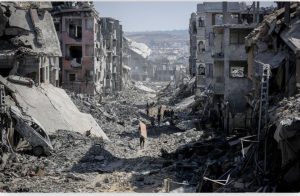 by Syarif Hidayat*
by Syarif Hidayat*
Every time we are going to start a jama’ah prayer (a congregational prayer), Imam of the Jama’ah always calls out to all worshippers to pay attention that everyone should “Straighten row and close ranks because that is part of the perfection of our prayer!”
Islam pays a great deal of attention to the rows of worshippers, as it has enjoined straightening the rows and speaks clearly of the virtue and importance of straightening them. It was narrated from Anas ibn Maalik (may Allah be pleased with him) that Prophet Muhammad (peace and blessings of Allah be upon him) said: “Straighten your rows, for straightening the rows is part of perfecting prayer.”
It is obligatory for the Muslims during Jama’ah prayer to make their rows straight and compact and to close the gaps between them. That is done by standing shoulder-to-shoulder and foot-to-foot. It was narrated from ‘Abd-Allaah ibn ‘Umar that the Messenger of Allaah (peace and blessings of Allah be upon him) said: “Make your rows straight, stand shoulder to shoulder and close the gaps, and do not resist your brothers’ hands. Do not leave any gaps for the Shaytaan. Whoever complete a row, Allaah will reward him, and whoever breaksa row, Allah will forsake him“.
Also Read: Imaam Yakhsyallah: Nurture Love for the Prophet, One Will Be with Whom One Loves
Abu Dawood said: What is meant by “Do not resist your brothers’ hands” is that a man should be easy-going if his brother pushes him forwards or backwards to make the row straight.
The Sunnah is for the imam to stand in the front, in line with in the middle of the row, then the rows should start from behind the imam, not from the right hand side of the mosque or the left, as some people do.
Rather they should start from behind the imam, then the row should be completed to both the right and the left, so as to follow the Sunnah of having the imam in the middle.
Based on this, then whoever is in the right half of the row should look to his left and align himself with whoever is on his left and whoever is in the left half should look to his right and align himself with whoever is on his right…
Also Read: Thanksgiving: An Islamic Perspective
“With regard to the gaps between the feet, the worshipper should stand in a moderate fashion, neither standing with his feet together nor making them too far apart, because the further apart he makes them, the further his shoulders will be from his neighbour’s shoulders.
Making the rows straight and compact is achieved by standing foot-to-foot and shoulder-to-shoulder.” (Islam Q & A)
Arranging the rows during prayer
Many people do not know that it is from the sunnah to stand feet to feet and so during a jama’ah prayer, they leave a small gap in between. To what extent are we obliged to try and fill the gap by spreading our feet further apart? If the line is not straight, do we align ourselves to the person on our right, or the one on the left?.
Also Read: Achieving the Position of Fasting Expert with Kindness of Morality
 Let the imam stand in the middle
Let the imam stand in the middle
Narrated Abu Hurairah: “Let the Imam stand in the middle (so that those praying behind him should be standing both on his right and his left) and close the gaps.” (Abu Dawud)
The Sunnah for the imam is to stand in line with the middle of the row, so the row should start from right behind the imam, and then be completed first to his right and to his left. It does not matter if there are slightly more people on the right than on the left.
Moreover, as stated by the Islamic scholars, he who will stand right behind the imam should be a person that has enough knowledge to be imam (in order to go on salah as imam in case that the imam has any problems and have to leave the salah).
Also Read: The Power of Charity in Ramadan
Narrated Aishah : “Allah and His angels invoke blessings upon those who are on the right side of the rows.” (Abu Dawud, Salât, 95; Ibni Majah, Iqamah, 55)
While joining a congregational prayer, the first rows should be filled at first. To fill the first rows means not to start a new row unless the gaps in the front one are filled.
Narrated Abu Umamah: “Complete the front row, then the ones after it, and if there is any incompletion, it should be in the last row.” (Abu Dawud, Salat,93; Nasai, Imamat, 30; Baihaqi)
Jabir ibn Samurah said: “Prophet Muhammad (pbuh) came to us and said: ‘Why don’t you make the rows like the angels make their rows in the presence of their Lord?’ We asked: ‘O Messenger of Allah, how do the angels make their rows in the presence of their Lord?’ He replied; ‘they complete the first row and stand closely together, side by side, in the row.'” (Bukhari, Tirmidhi)
Also Read: Ramadan Brings the Change
The importance of straightening the rows
Related Anas: “The Prophet (pbuh) would turn his face to us before he began the salah and he would say: ‘Be close together and straighten your rows.'” (Bukhari , Muslim). He also reported that the Prophet (pbuh) would say: “Make your rows straight for the straightening of the rows is part of the completion of the salah.” (Bukhari , Muslim, Ebû Dâvud, Nasâî)
Narrated Nu’man ibn Basheer: “Straighten your rows (he said it three times),by Allah either you straighten your rows or Allah will cause conflict between your hearts.” (Abu Dawud , Ibn Hibbaan [396], Ahmad [4/276] )
Ibn `Umar reported: “The Messenger of Allah (pbuh) said, “Arrange the rows in order, stand shoulder to shoulder, close the gaps, be accommodating to your brothers, and do not leave gaps for Satan. Whoever joins up a row, he will be joined to Allah (i.e., to the Mercy of Allah); and whoever cuts off a row, he will be cut off from Allah (i.e., from His Mercy).” (Abu Dawud)
Also Read: Ramadan, the Month of Education
Straightening the rows requires straightening it with the alignment of heels: While straightening the rows of a congregational prayer, it is essential to regard the alignment of the heels to straighten the rows, because if the alignment of the tips of toes is regarded, as the sizes of all feet are different, the rows will be irregular and crooked.
According to another report narrated by al-Bukhaari (723): “Straighten your rows, for straightening the rows is part of establishing prayer.”
It was narrated that Abu Mas’ood (may Allaah be pleased with him) said: The Messenger of Allah (peace and blessings of Allah be upon him) used to touch our shoulders when we were praying and he would say: “Make the rows straight and do not differ, lest your hearts differ.”
It was narrated that al-Nu’maan ibn Basheer (may Allah be pleased with him) said: The Messenger of Allah (peace and blessings of Allah be upon him) used to straighten our rows, as if he was straightening the shaft of an arrow, until he saw that we had learned it.
Also Read: Come on Do I’tikaf
Then he came out one day and was about to say the takbeer, when he noticed a man whose chest was sticking out from the row. He said: “Slaves of Allah! Make your rows straight or Allah will cause discord among you.” Narrated by al-Bukhaari, 717; Muslim, 436.
Al-Nawawi said in Sharh Muslim: With regard to the phrase “[he] used to straighten our rows, as if he was straightening the shaft of an arrow”, the qadaah is the wooden shaft of the arrow where it is pared and trimmed, i.e., he paid such great attention to straightening the rows, as if he was straightening the shaft of an arrow, because they were so straight.”
These texts clearly show that it is obligatory to straighten the rows. Al-Bukhaari (may Allah have mercy on him) said in his Saheeh: “Chapter: The sin of those who do not complete the rows”, in which he narrated with his isnaad from Bushayr ibn Yasaar al-Ansaari from Anas ibn Maalik that he came to Madeenah and it was said to him: What do you find has changed in us since the time of the Messenger of Allah (peace and blessings of Allah be upon him)? He said: I do not find anything except that you do not straighten your rows. Narrated by al-Bukhaari, 724.
Al-Haafiz ibn Hajar said in Fath al-Baari: This is to be understood as meaning that al-Bukhaari understood it to be obligatory from the form of command in the words of the Prophet (peace and blessings of Allah be upon him): “Straighten your rows,” and from the general meaning of his words, “Pray as you have seen me praying,” and from the warning issued against failing to do that.
Also Read: During Ramadan, Merit and Good Deeds are Multiplied
So in his view, on the basis of this evidence, Anas was criticizing a failure to do something that is obligatory, although a criticism may also come for failing to do something that is Sunnah.
Although straightening the rows is obligatory, the prayer of those who fail to do that and do not straighten their rows is still valid. That is supported by the fact that although Anas criticized them, he did not tell them to repeat their prayer. End quote.
Shaykh Ibn ‘Uthaymeen (may Allaah have mercy on him) said:
The words “or Allah will cause discord among you” … this is undoubtedly a warning to those who fail to straighten their rows. Hence some of the scholars are of the view that it is obligatory to make the rows straight.
Also Read: Ramadan, The Month of Jihad
They quoted as evidence for that the fact that the Prophet (peace and blessings of Allah be upon him) enjoined it and warned those who went against his command.
If something is enjoined and a warning issued against doing the opposite, it cannot be said that it is “only Sunnah”. Hence the correct view on this matter is that it is obligatory to straighten the rows, and if the congregation does not straighten the rows, then they are sinning. This is the apparent meaning of the words of Shaykh al-Islam Ibn Taymiyah.
Straightening the rows is obligatory so that no one will stand in front of anyone else, whether that is by his chest or his foot sticking out.
It says in ‘Awn al-Ma’bood: What is meant by straightening the rows is for the people standing in the row to make a straight line.
Shaykh Ibn ‘Uthaymeen (may Allah have mercy on him) said:
Also Read: Increasing Social Care in the Month of Ramadan
Straightening the rows means that no one stands in front of anyone else, but is what is meant that the foot should not be in front of anyone else’s foot? The answer is that what is meant is the shoulders at the top of the body, and the heels at the bottom of the body.
Attention is paid to the heels because they are the foundation on which the body rests. The heel is at the bottom of the leg, and the leg is the pillar of the body, so this is what matters. As for the toes, they do not count, because toes vary; some people have long feet and some have short feet, so what matters is the heel.
There is another kind of straightening that means completeness or perfection, as Allah says (interpretation of the meaning): “And when he attained his full strength, and was perfect (in manhood)” [al-Qasas 28:14]
Completeness
Here the word astawa (translated as ‘was perfect’) means: was made complete. If we say istiwa’ al-sufoof (straightening of the rows) in the sense of completeness, that does not detract from the meaning of straightening them in the sense of ensuring that everyone stands parallel, rather it encompasses a number of meanings:
1 – Straightness in the sense of standing parallel, which according to the correct view is obligatory, as stated above.
2 – Making the rows compact, which is part of making them complete or perfect. The Prophet (peace and blessings of Allaah be upon him) used to enjoin that, and he urged his ummah to form rows as the angels do before their Lord, filling in and completing the rows one by one. But what is meant by making the rows compact is not leaving gaps for the devils; it does not mean crowding and cramming people in, because there is a difference between making it compact and making it crowded. Hence the Prophet (peace and blessings of Allaah be upon him) used to say: “Make the rows straight, and make the shoulders parallel… and do not leave gaps for the devils.”
i.e., there should be no gaps between you through which the devils can enter, because the devils enter among the rows like small lambs so that they can spoil the prayer of the worshippers.
3 – Completing the first row and then the next. This is part of straightening the rows. The second row should not be begun until the first row is completed, and the third row should not be begun until the second row is completed, and so on. The Prophet (peace and blessings of Allaah be upon him) urged completing the first row and said: “If the people knew what there is in the call and the first row, but they had no way other than drawing lots, then they would draw lots.” I.e., if two people came to the first row and one of them said, “I am more entitled to it than you,” and the other said, “I am more entitled,” and he said: “Let us draw lots to see which of us will be in this spot.”
One of the ways in which the Shaytaan plays with people nowadays is when they see that the first row is only half full, but despite that they start the second row, then when the iqaamah is given, and it is said to them, “Complete the first row,” they start looking around in confusion.
4 – Another aspect of straightening the rows is making the rows close to one another and close to the imam, because they are a jamaa’ah (congregation, group) and the word jamaa’ah is taken from the word ijtimaa’ (coming together). There can be no proper coming together if the rows are far apart. The closer the rows are to one another and to the imam, the better it is. In some mosques we see gaps between the imam and the first row that are so wide that another row or two could fit in, because the imam goes so far forward. I think that this stems from ignorance. The Sunnah is for the imam to be close to the people who are praying behind him, and the people should be close to the imam, and each row should be close to the other. The definition of close is that there should be enough room between them to prostrate and a little more.
5 – Another aspect of straightening the rows is to draw close to the imam, because the Prophet (peace and blessings of Allaah be upon him) said: “Let those among you who are men of wisdom and understanding be closest to me.” The closer the better. Hence it is encouraged to draw close to the imam in Jumu’ah prayers, because drawing close to the imam in Jumu’ah prayers is achieved by drawing close to him during the prayer and during the khutbah. Drawing close to the imam is something desirable, but some people are negligent concerning that and are not keen to do it.
6 – Another aspect of straightening the rows is preferring the right hand side of the row to the left, i.e., the right side of the row is better than the left, but that is not in absolute terms, as in the case of the first row, because if it was in absolute terms, as in the case of the first row, the Messenger (peace and blessings of Allaah be upon him) would have said, “Complete the right side then the right side,” as he said, “Complete the first row then the next.” The right side is better than the left if both right and left are roughly equal, such as if there are five on the right and five on the left, then the eleventh man comes. In that case we tell him: Go to the right, because the right is better when both sides are equal or almost equal, such that the difference between the right and left is not obvious. But if there is a difference, then undoubtedly the left side of a closer row is better than the right side of a more distant row. This is indicated by the fact that if the congregation is just three people, the imam should stand between them, i.e., between the other two. This indicates that the right is not better in absolute terms, because if it were better in absolute terms, it would be better for the two people to stand on the right of the imam, but what is prescribed is that one should be on the right and one on the left so that the imam is in the middle and there is no imbalance on one side.
7 – Another aspect of straightening the rows is that the women should stand on their own, i.e., the women should be behind the men, not mixed with the men, because the Prophet (peace and blessings of Allaah be upon him) said: “The best rows for men are the first rows and the worst are the last, and the best rows for women are the last rows and the worst are the first.” The Prophet (peace and blessings of Allaah be upon him) stated that the further women are behind the men, the better.
So it is better for women to be far behind the men, because of the fitnah involved in their being close to men. Worse than that is their mixing with the men, where a woman would be beside a man or a row of women would be between two rows of men. This is not appropriate and as well as being haraam there is the fear of fitnah.
It is more likely to be haraam when there is the fear of fitnah, but even when there is no fitnah, this is still not appropriate, such as if the women are mahram of the men. Al-Sharh al-Mumti’, 3/13-17.
A bond of love and mutual understanding
Shaykh Ahmed Abdul Mujeeb Qasmi Nadvi in his article titled “Importance of proper rows in prayers” (translated by Muhammad Owais Jafrey) published by www.islameasy.org writes “We all know and should know the importance of Salat in our individual and collective life. Salat is a great and magnificent worship. Prophet (SAW) instructed us to pray in congregation and mentioned limitless rewards on such a worship.”
“Congregational prayers create among us a bond of love and mutual understanding. This arouses in us the sense of our collective unity and fosters among us an international fraternity. Praying in congregation inculcates in us a deep feeling of brotherhood. Prayers are also a symbol of equality, for the poor and the rich, the low and the high, the rulers and the ruled, the educated and the unlettered, the black and the white, all stand in one row and prostrate before One Lord. Congregational prayers inculcate in us a strong sense of discipline and organization and obedience to the Imam who leads the prayer. In short, prayers train us in all those virtues which make possible the development of a rich individual and collective life.”
One special instruction of Prophet Muhammad PBUH mentioned on many occasions was to be very careful about straightening the rows. First the front rows should be filled and then ones in the rear. People who are elderly, responsible and those who are knowledgeable should try to find a place near the Imam. The reason for such instructions was make the congregation more disciplined, organized and effective. There are many traditions in the regard and people who are careless have been warned. It is very sad that either we totally disregard them, or take them very lightly. I am presenting some of the traditions to refresh your memory. We should try to practice them and also share with others for collective awareness.
Jaabir bin Samurah narrated that Allah’s Messenger (SAW) once came to us and said, “Why do you not draw yourselves up in rows as the angels do before their Lord?” We asked: “Ya Messenger of Allah! How do angels draw themselves up in rows before their Lord.” He replied, “They fill each row beginning with the first and keep close to one another in the row,” (Muslim).
Abu Hurairah (RA) quotes Prophet (SAW), who said: “The best of the men’s rows [in Salat] is the first row and the worst is the last; but for women’s row is the last and the worst of their rows is the first.” (Muslim)
Abu Said Khudri narrates that when Allah’s Messenger (SAW) perceived a tendency among his companions (RAA) to stand in the back rows, he said to them: “Come forward and be close to me and let those who come after you, follow your lead. (Remember!) If people continue to fall behind (i.e. in acquiring virtues), Allah puts them behind.” (Muslim).
Moving Children from the First Rows during Prayer
Some scholars are of the opinion that children are to be positioned in the last rows in Prayer and that if any of them has stood in the first rows, they are to be moved to the back ones.
However, the most dependable opinion in this regard is that if a child who can reason and know right from wrong has arrived earlier to the Mosque and stood in the first row to perform Prayer, he has every right to remain in that place until the end of the Prayer, and nobody is to move him to a back row.
If a man, even an old one, comes after that child, he is to stand in the row behind the child (if the child’s row is completed). This is because moving children to the back rows may make them feel belittled and thus make them dislike going to Mosques, and Allah Almighty would not ordain that.
In this regard, we would like to cite for you the following fatwa issued by the eminent scholar, Sheikh Ibn al-Uhaymeen, (may Allah have mercy upon him): “Does arranging rows in Salah require that men stand in the first rows and children in the back ones?
Some scholars say that adults should immediately follow the imam and that children should be in the back rows. If, for example, the row is to be formed of a hundred persons and there are a hundred men and a hundred boys prepared to perform the Prayer, the hundred men are to form the first row and the boys are to form the second one because putting the rows in order requires that the adults follow the imam.
Those scholars quote as their evidence for such opinion the Prophet’s Hadith: “Let the wise men among you stand behind me in the Salah.” But such an opinion needs to be reviewed. My point of view in that respect is that if a child goes earlier to the Mosque and stands in a certain place for Prayer, he has every right to that place.
There is much evidence to the effect that he who gets something before anyone else has every right to it. Besides, Mosques are Allah’s houses where all people are to be treated equally; so, if a child goes first to a Mosque and stands or sits in the first row, he is to remain there (till the end of the Prayer or the speech of the imam).
Furthermore, if we say that children are to be moved from the best place (the first rows) and be positioned in the last row, they might give up concentrating in the Prayer or the speech and start playing with one another.
In fact, the question of moving the children to the back rows in Prayer is a confusing one. If the children were to be moved, what would the adults do if they went to the Mosque after the Prayer had already begun, with the children occupying the first row and performing the Prayer? And if the children were to stay in the first rows, they might cause the men in the following rows to be distracted.
Besides, moving the children to the back rows may result in two undesirable things. The first one is that the children moved may dislike going to Mosques, for moving them against their will belittles them. Children should not be treated like this, for they do not easily forget the way they are dealt with.
The second thing is that the children may dislike the men who have moved them to the back rows. To sum up, the opinion that the children are to be moved from the first rows in the Prayers to the back ones is a weak one. As for the Prophet’s Hadith “Let the wise men among you stand behind me in the Salah,”, its indication is that the Prophet (peace be upon him) meant to encourage men to go to the Mosques early and occupy the first rows, not that the children are to be moved from the first rows to the back ones.” Allah Knows Best.
(T/E1/P04)
Mi’raj News Agency (MINA)
This article has also been published in the website: UNDERSTANDING ISLAM
*Editor MINA (He can be contacted via email:[email protected])
Bibliotheque:
1.http://askaquestionto.us/question-answer/salah/
5. http://www.onislam.net/


























 Mina Indonesia
Mina Indonesia Mina Arabic
Mina Arabic